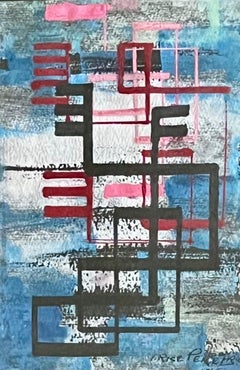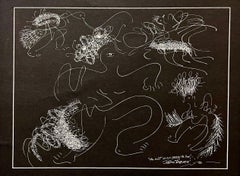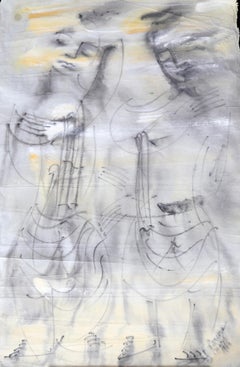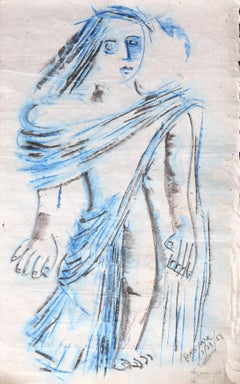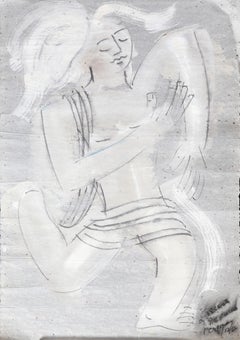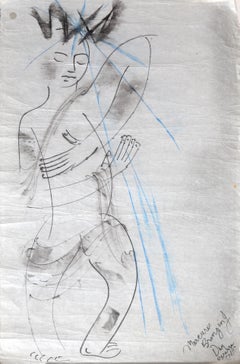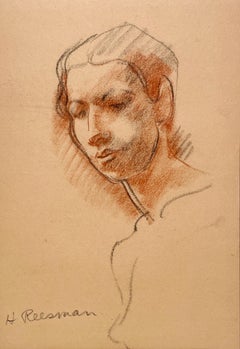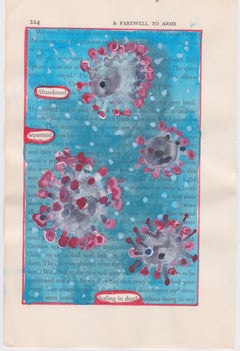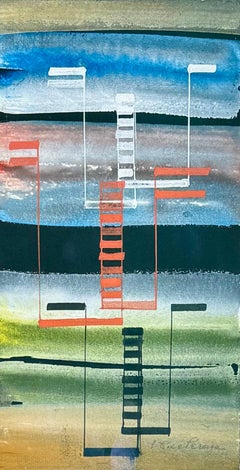Irene Rice Pereira Drawings and Watercolor Paintings
American, 1902-1971
Born Irene Rice, she took the name of her first husband, the commercial artist Umberto Pereira. She adopted the name I. Rice Pereira because then as now discrimination beset women in the arts. By the time war broke out Irene had divorced Pereira and married George Wellington Brown, a marine engineer from a prominent Boston family. Brown was an ingenious experimenter with materials, and he encouraged his petite new wife in their mutual passion for experimentation. Pereira in the 1930s was drawn to ships, not only because of George Brown, but because of their intricate machinery, their functional beauty. The inside-out infrastructure of the Pompidou museum in Paris amused Pereira, although she thought it art-historically tardy.
Irene Rice Pereira was a lovely, fragile being. Her presence was hushed. She spoke almost in a whisper and listened far more than she spoke. She was a prodigious autodidact and a spellbinding lecturer. The main body of her metaphysical library today resides in the Museum for Women in the Arts in Washington, D.C. Her papers and the manuscript for her still unpublished book, Eastward Journey, are available to scholars in the Schlesinger Library at Harvard.
Pereira won recognition for her abstract geometric work, particularly her jewel-like works on fluted and coruscated layers of glass, throughout the 1940s and early 1950s. In 1953 the Whitney Museum, then in Greenwich Village, gave her a retrospective exhibition with Loren MacIver, and that same year Life magazine published a centerfold photo examination of her work.
By the late 1950s Abstract Expressionism had swept Manhattan, flattening such nascent movements as Geometric Abstraction. Such artists as Stuart Davis, Stanton MacDonald Wright, George L.K. Morris, George Ault, Jan Matulka, Richard Leahy, Philip Guston and many others were eclipsed. Pereira believed that a European angst, brought to our shores in the wake of the Holocaust, had introduced a cynicism and a profoundly anti-female sensibility that boded ill for art in America. Rightly she pointed out that even when the works of women were acquired by museums they were rarely shown, a disgrace that persists to this day. The women who did achieve success, she said, were often collaborators with more famous male artists and tastemakers.
Pereira died in 1971 in Marbella, Spain, ill and broken-hearted. She had been evicted from the Fifteenth Street studio in Chelsea where she had painted for more than thirty years. Suffering from severe emphysema, she could barely negotiate a few stairs.
But by the 1980s a new generation of women scholars and curators had begun to resurrect her stature. A considerable following has formed to honor a pioneer artist who cared about other artists and willingly paid the price to denounce what others feared in silence. Indeed when Pereira sold a painting she had two immediate impulses: buy a new hat, and give the money to an artist friend in trouble. She loved hats but loved to help fellow artists even more.to
2
1
5
Overall Width
to
Overall Height
to
8
1
2
4
5
3
7
1
5
3
3
3
1
6
5
4
2
2
20
933
406
282
279
1
5
8
Artist: Irene Rice Pereira
ABSTRACT American Woman Abstract Non-objective Mid 20th Century Modern Drawing
By Irene Rice Pereira
Located in New York, NY
ABSTRACT American Woman Abstract Non-objective Mid 20th Century Modern Drawing
Irene Rice Pereira (1902-1971)
Abstract
8 1/2 x 5 1/2 inches
Watercolor, gouache, and ink on black paper
Signed lower right
Framed by Bark
BIO
rene Pereira was born in 1902 in Chelsea, Massachusetts and grew up in Great Barrington. She was strongly influenced by her mother who was an amateur artist. Irene began art lessons at the age of fifteen; she took a secretarial job because her father had died. She took art classes at the Art Students League in New York City. At the age of twenty-one she married the first of three husbands, Humberto Pereira, whose name she kept.
She traveled extensively in Europe and North Africa and was much inspired by the expansive vistas of the Sahara Desert. Returning to New York, she began incorporating these visions into her work, increasingly experimental in her styles and methods. At first she painted on canvas, then she devised a means of actually incorporating light into her works by painting on layers of glass and mounting the layers together.
In 1942 she married George Brown, an engineer, who helped her experiment with a variety of materials. By the 1950s she became more interested in writing poetry and, divorced from Brown in 1952, she married George Reavey, an Irish Poet...
Category
1950s Abstract Irene Rice Pereira Drawings and Watercolor Paintings
Materials
Paper, Watercolor, Gouache
Irene Rice Pereira Modernist Gouache Drawing Painting Abstract Expressionist Art
By Irene Rice Pereira
Located in Surfside, FL
Irene Rice Pereira,
Mixed Media on Paper (American, 1902-1971)
Titled "The East Wind Carries the Seed"
Hand signed l.r. "I. Rice Pereira".
Paper: 14.1/8"h x 18.25"w
Irene Rice Pe...
Category
Mid-20th Century Abstract Expressionist Irene Rice Pereira Drawings and Watercolor Paintings
Materials
Paper, Gouache
Mars, 1966 Mixed Media by Irene Rice Pereira
By Irene Rice Pereira
Located in Long Island City, NY
Mars
Irene Rice Pereira, American (1902-1971)
Creation Date: 1966
Acrylic and pastel on rice paper, signed, dated, and titled in pastel
Size: 39 x 24.75 in. (99.06 x 62.87 cm)
Category
1960s Modern Irene Rice Pereira Drawings and Watercolor Paintings
Materials
Pastel, Acrylic
Blue Woman, 1958 Pastel by Irene Rice Pereira
By Irene Rice Pereira
Located in Long Island City, NY
Blue Woman
Irene Rice Pereira, American (1902-1971)
1958
Pastel on rice paper, signed and dated in pastel
Size: 36.5 x 25 in. (92.71 x 63.5 cm)
Category
1950s Modern Irene Rice Pereira Drawings and Watercolor Paintings
Materials
Pastel
Descent of Mercurius, 1962 Mixed Media by Irene Rice Pereira
By Irene Rice Pereira
Located in Long Island City, NY
Descent of Mercurius
Irene Rice Pereira, American (1902-1971)
1962
Pastel and Acrylic on rice paper, signed, titled and dated in pastel
Size: 35 x 23.75 in. (88.9 x 60.33 cm)
Category
1960s Modern Irene Rice Pereira Drawings and Watercolor Paintings
Materials
Pastel, Acrylic
Mercurius Bringing Day, 1940 Pastel by Irene Rice Pereira
By Irene Rice Pereira
Located in Long Island City, NY
Mercurius Bringing Day
Irene Rice Pereira, American (1902-1971)
1940
Pastel on rice paper, signed, titled and dated in pastel
38.5 x 24.5 in. (97.79 x 62.23 cm)
Category
1940s Modern Irene Rice Pereira Drawings and Watercolor Paintings
Materials
Pastel
The Descent of the Dove, 1967 Pastel by Irene Rice Pereira
By Irene Rice Pereira
Located in Long Island City, NY
The Descent of the Dove
Irene Rice Pereira, American (1902-1971)
1967
Pastel on rice paper, signed and titled in marker, dated in pastel
39 x 24.75 in. (99.06 x 62.87 cm)
Category
1960s Modern Irene Rice Pereira Drawings and Watercolor Paintings
Materials
Pastel
Abstraction
By Irene Rice Pereira
Located in New York, NY
I . Rice Pereira
Abstraction
Pastel. Signed. 9 1/8 x 5 7/8"
I.Rice Pereira was an American abstract artist, poet, and philosopher who played a significant rol...
Category
1960s Abstract Geometric Irene Rice Pereira Drawings and Watercolor Paintings
Materials
Oil Pastel
Price Upon Request
Related Items
A Fine 1946 Modern Portrait Figure Study of a Handsome Young Male Model / Artist
By Harold Haydon
Located in Chicago, IL
A Fine 1940s, Mid-Century Modern Academic Portrait Figure Study of a Handsome Young Male Model by Notable Chicago Artist, Harold Haydon (Am. 1909-1994). An exceptionally well execut...
Category
1930s American Modern Irene Rice Pereira Drawings and Watercolor Paintings
Materials
Paper, Charcoal, Pastel
$235
H 24 in W 18 in D 0.13 in
"#224 – ABANDONED, SEPARATED", ink, pencil, gouache, found book, poetry, virus
By Amy Williams
Located in Toronto, Ontario
"#224 – ABANDONED, SEPARATED" is from Amy Williams' series A Farewell to Arms – wherein the artist works directly onto page 224 of a found copy of Ernest ...
Category
21st Century and Contemporary Abstract Irene Rice Pereira Drawings and Watercolor Paintings
Materials
Paper, Found Objects, Ink, Gouache, Pencil
"#71 – THEN IT'S HOPELESS?", ink, pencil, gouache, found vintage book, poetry
By Amy Williams
Located in Toronto, Ontario
"#71 – THEN IT'S HOPELESS?" is from Amy Williams' series A Farewell to Arms – wherein the artist is working directly onto page 71 of a found copy of Ernest Hemingway's WWII romance novel. The artist selects certain words and phrases from the page to isolate as a poem, and then draws, inks, redacts and paints the rest of the page according to the text of the poem. Here the poem reads: "Then it's hopeless? / But sometimes I cannot hope. / I cannot." Note the poem is outlined in dark red and purple radiating lines, while outside there are lighter violet, blue and white lines.
From Amy Williams – "My recent work is focused on making treated book pages using a found vintage...
Category
21st Century and Contemporary Abstract Irene Rice Pereira Drawings and Watercolor Paintings
Materials
Paper, Found Objects, Ink, Gouache, Pencil
Modern Dancers
By Mick Micheyl
Located in London, GB
'Modern Dancers', pastel, ink and gouache on fine art paper by French artist, singer and sculptor, Mick Micheyl (1964). Two elegant young men are depicted in a graceful dancing pose, arms outstretched, their lithe bodies so agile and limber. Perhaps one of the dancers was her friend, Philippe, to whom the painting is dedicated on the bottom. The dedication says: 'For you Philippe, all my friendship'. Signed: 'Mick Micheyl'. The work has been newly framed and glazed after having been acquired in the S. of France. It is in fair vintage condition commensurate with age showing minor blemishing on the paper. Upon request a video of the piece can be provided.
Dimensions with Frame:
H 75 cm / 29.5"
W 61 cm / 24"
Dimensions without Frame:
H 56 cm / 22"
W 42 cm / 16.5"
About the Artist: Mick Micheyl (1922 - 2019) was born in Lyon and had a busy and rewarding artistic career as a singer, producer, reviewer, metal sculptor, artist. After having received training at the School of Fine Arts in Lyon she became a painter and decorator in the theatre but then commenced a career in the musical activities of a theatrical troupe. She won the ABC competition in Paris in 1949 with a song, Le Marchand de Poésie, which she composed herself. She then performed in many cabarets: L'Échelle de Jacob, Harlequin and Liberty's. In the 1950s she was one of the most important French cabaret singers of that period. One of her titles, 'Un Gamin de Paris', became one of the French standards and also performed by Yves Montand and Robert Clary...
Category
1960s Modern Irene Rice Pereira Drawings and Watercolor Paintings
Materials
Paper, Pastel, Ink, Gouache
"#56 – BOTH WOUNDED A LITTLE", ink, pencil, gouache, collage, found text, poetry
By Amy Williams
Located in Toronto, Ontario
"#56 – BOTH WOUNDED A LITTLE" is from Amy Williams' series A Farewell to Arms – wherein the artist is working directly onto page 56 of a found copy of Ernest Hemingway's WWII romance...
Category
21st Century and Contemporary Abstract Irene Rice Pereira Drawings and Watercolor Paintings
Materials
Paper, Found Objects, Ink, Gouache, Pencil
Abstract Watercolor Painting, 'Design for Sculpture', C. 2000 by David Ruth
By David Ruth
Located in Oakland, CA
This is a contemporary abstract watercolor painting by artist David Ruth. This series of paintings often feature bright colors and vibrant layouts that draw the viewer in. They are c...
Category
Early 2000s Abstract Expressionist Irene Rice Pereira Drawings and Watercolor Paintings
Materials
Paper, Watercolor
La femme aux fleurs (Portrait de Mathilde See)
By Paul César Helleu
Located in New Orleans, LA
Paul César Helleu is regarded among the most sought-after society portraitists of his era, and his Belle Époque works rival those of his contemporaries John Singer Sargent and Giovanni Boldini. He is best remembered for capturing the era's most beautiful socialites, including Consuelo Vanderbilt, the Duchess of Marlborough, the Comtesse de Loriol Chandieu and the Comtesse Mathieu de Noailles, among others. This work, however, stands out in that it captures the charming likeness of one of his art world cohorts, Mathilde See, a Parisian-born decorator and painter of floral still lifes. She is the essence of the modern woman, captured in her fashionable dress as she strolls along the flower-lined streets of Paris.
Commanding in size, Portrait de Mathilde See fully displays Helleu's mastery over the medium of pastel. The muted palette of greys and blues is typical of the artist, bringing a harmony and cohesiveness to the composition. Furthermore, Helleu cleverly alludes to See's own artistic output with a backdrop of vibrant floral blooms, enlivening the canvas and complementing the greens and blues of the peacock feather adorning her hat.
The portrait is all the more significant thanks to its provenance. It was previously in the collection of A. Alfred Taubman, one of America's most successful entrepreneurs and one-time owner of Sotheby's. Considering Taubman encountered some of the most noteworthy and beautiful works of art ever made through his auction house, the fact that he chose this portrait by Helleu to grace his collection is a testament to its import.
Born in Brittany in 1859, Helleu moved to Paris in 1876 in order to study at the École des Beaux-Arts. Like so many other artists of his generation, he was trained there under the Academic master Jean-Léon Gérôme. That same year, he also attended the Second Impressionist Exhibition...
Category
20th Century Modern Irene Rice Pereira Drawings and Watercolor Paintings
Materials
Linen, Pastel
$425,000
H 61.38 in W 48.25 in
"#227 – I WAS AFRAID", ink, pencil, gouache, found book, poetry, coronavirus
By Amy Williams
Located in Toronto, Ontario
"#227 – I WAS AFRAID" is from Amy Williams' series A Farewell to Arms – wherein the artist works directly onto pages of a found copy of Ernest Hemingway's WWII romance novel. The art...
Category
21st Century and Contemporary Abstract Irene Rice Pereira Drawings and Watercolor Paintings
Materials
Paper, Found Objects, Ink, Gouache, Pencil
"#152 – GOOD GIRL", ink, pencil, gouache, found vintage book, hemingway, poetry
By Amy Williams
Located in Toronto, Ontario
"#152 – GOOD GIRL" is from Amy Williams' series A Farewell to Arms – wherein the artist is working directly onto page 152 of a found copy of Ernest Heming...
Category
21st Century and Contemporary Abstract Irene Rice Pereira Drawings and Watercolor Paintings
Materials
Paper, Found Objects, Ink, Gouache, Pencil
Study #26, 1960s Gouache painting Signed Framed Pace & Hudson Gallery provenance
By Jack Youngerman
Located in New York, NY
Jack Youngerman
Untitled Study #26, 1967
Gouache painting on paper (with original JL Hudson and PACE Gallery labels)
Hand signed and dated '67 on the front; J.L. Hudson Gallery Label on Verso.
Unique Abstract Expressionist work on paper
Frame included
Framed
Measurements:
Framed:
15 inches by 15 inches by 1.5 inch
Artwork:
7.75 inches by 7.5 inches
Provenance
From the estate of Anne Markley Spivak
J. L. Hudson Gallery Label affixed to verso (back).
The J.L. Hudson Gallery, Detroit, Michigan
This 1967 unique, signed gouache painting by renowned abstract expressionist painter Jack Youngerman was acquired from the estate of Anne Markley Spivak. It is held in the original vintage metal frame with the original J.L. Hudson Gallery label, as well as the PACE gallery label on the verso
The artwork has been newly loated and framed in a museum quality white wood frame; the original labels from the original back board have been affixed to the back to preserve provenance.
Jack Youngerman Biography
Jack Youngerman was born in St. Louis, Missouri on March 25, 1926. He moved to Louisville, Kentucky in 1929 and studied at the University of Missouri, Columbia from 1944 to 1946 under a wartime navy training program. He graduated from the University of North Carolina Chapel Hill in 1947 and, that same year, he returned to Missouri to finish his Bachelor’s degree in Journalism before moving to Paris on a G.I. scholarship.
In Paris, Youngerman enrolled at the Ecole des Beaux-Arts, studying drawing with Jean Souverbie. He explored Paris, taking in the cathedrals, museums, and history in order to grasp a greater sense of art history. He also traveled to the Netherlands, Spain, Belgium, Italy, and Greece on fine art excursions.
In 1948, Youngerman became friends with Ellsworth Kelly, Eduardo Paolozzi, and Cesar – fellow students at Ecole des Beaux-Arts. He married Delphine Seyrig in 1950, and later that year he had his first group exhibition at Galerie Maeght in Paris. He visited the studios of Constantín Brancusi and Jean Arp and became heavily influenced by the organic forms present in their work. He also met artist Alexander Calder through his father-in-law, Henri Seyrig, and experimental filmmaker and artist, Robert Breer...
Category
1960s Abstract Expressionist Irene Rice Pereira Drawings and Watercolor Paintings
Materials
Gouache
$15,000
H 15 in W 15 in D 1.5 in
Portrait Of A Woman
Located in Lake Worth Beach, FL
Portrait of a Woman
Pencil signed and dated Feb 20. 20 unframed 14x11
George Kenneth Hartwell painter and illustrator was born in Fitchburg 1891-1949, Massachus...
Category
1920s American Modern Irene Rice Pereira Drawings and Watercolor Paintings
Materials
Paper, Pastel, Pencil
Rare Modernist Hungarian Rabbi Pastel Drawing Gouache Painting Judaica Art Deco
By Hugó Scheiber
Located in Surfside, FL
Rabbi in the synagogue at prayer wearing tallit and tefillin.
Hugó Scheiber (born 29 September 1873 in Budapest – died there 7 March 1950) was a Hungarian modernist painter.
Hugo Scheiber was brought from Budapest to Vienna at the age of eight where his father worked as a sign painter for the Prater Theater. At fifteen, he returned with his family to Budapest and began working during the day to help support them and attending painting classes at the School of Design in the evening, where Henrik Papp was one of his teachers. He completed his studies in 1900. His work was at first in a post-Impressionistic style but from 1910 onward showed his increasing interest in German Expressionism and Futurism. This made it of little interest to the conservative Hungarian art establishment.
However, in 1915 he met the great Italian avant-gardist Filippo Tommaso Marinetti and the two painters became close friends. Marinetti invited him to join the Futurist Movement. The uniquely modernist style that he developed was, however, closer to German Expressionism than to Futurism and eventually drifted toward an international art deco manner similar to Erté's. In 1919, he and his friend Béla Kádar held an exhibition at the Hevesy Salon in Vienna. It was a great success and at last caused the Budapest Art Museum to acquire some of Scheiber's drawings. Encouraged, Scheiber came back to live in Vienna in 1920.
A turning point in Scheiber's career came a year later, when Herwarth Walden, founder of Germany's leading avant-garde periodical, Der Sturm, and of the Sturm Gallery in Berlin, became interested in Scheiber's work. Scheiber moved to Berlin in 1922, and his paintings soon appeared regularly in Walden's magazine and elsewhere. Exhibitions of his work followed in London, Rome, La Paz, and New York.
Scheiber's move to Germany coincided with a significant exodus of Hungarian artists to Berlin, including Laszlo Moholy-Nagy and Sandor Bortnyik. There had been a major split in ideology among the Hungarian avant-garde. The Constructivist and leader of the Hungarian avantgarde, Lajos Kassák (painted by Hugó Scheiber in 1930) believed that art should relate to all the needs of contemporary humankind. Thus he refused to compromise the purity of his style to reflect the demands of either the ruling class or socialists and communists. The other camp believed that an artist should be a figurehead for social and political change.
The fall out and factions that resulted from this politicisation resulted in most of the Hungarian avant gardists leaving Vienna for Berlin. Hungarian émigrés made up one of the largest minority groups in the German capital and the influx of their painters had a significant effect on Hungarian and international art. Another turning point of Scheiber's career came in 1926, with the New York exhibition of the Société Anonyme, organized by Katherine Dreier. Scheiber and other important avant garde artists from more than twenty-three countries were represented. In 1933, Scheiber was invited by Marinetti to participate in the great meeting of the Futurists held in Rome in late April 1933, Mostra Nazionale d’Arte Futurista where he was received with great enthusiasm. Gradually, the Hungarian artists began to return home, particularly with the rise of Nazism in Germany. Kádar went back from Berlin in about 1932 and Scheiber followed in 1934.
He was then at the peak of his powers and had a special flair in depicting café and cabaret life in vivid colors, sturdily abstracted forms and spontaneous brush strokes. Scheiber depicted cosmopolitan modern life using stylized shapes and expressive colors. His preferred subjects were cabaret and street scenes, jazz musicians, flappers, and a series of self-portraits (usually with a cigar). his principal media being gouache and oil. He was a member of the prestigious New Society of Artists (KUT—Képzőművészek Új Társasága)and seems to have weathered Hungary's post–World War II transition to state-communism without difficulty. He continued to be well regarded, eventually even receiving the posthumous honor of having one of his images used for a Russian Soviet postage stamp (see image above). Hugó Scheiber died in Budapest in 1950.
Paintings by Hugó Scheiber form part of permanent museum collections in Budapest (Hungarian National Museum), Pecs (Jannus Pannonius Museum), Vienna, New York, Bern and elsewhere. His work has also been shown in many important exhibitions, including:
"The Nell Walden Collection," Kunsthaus Zürich (1945)
"Collection of the Société Anonyme," Yale University Art Gallery, New Haven, Connecticut (1950)
"Hugó Scheiber: A Commemorative Exhibition," Hungarian National Museum, Budapest (1964)
"Ungarische Avantgarde," Galleria del Levante, Munich (1971)
"Paris-Berlin 1900-1930," Centre Georges Pompidou, Paris (1978)
"L’Art en Hongrie, 1905-1920," Musée d’Art et l’Industrie, Saint-Etienne (1980)
"Ungarische Avantgarde in der Weimarer Republik," Marburg (1986)
"Modernizmus," Eresz & Maklary Gallery, Budapest (2006)
"Hugó Scheiber & Béla Kádár," Galerie le Minotaure, Paris and Tel Aviv (2007)
Hugó Scheiber's paintings continue to be regularly sold at Sotheby's, Christie's, Gillen's Arts (London), Papillon Gallery (Los Angeles) and other auction houses.
He was included in the exhibition The Art Of Modern Hungary 1931 and other exhibitions along with Vilmos Novak Aba, Count Julius Batthyany, Pal Bor, Bela Buky, Denes Csanky, Istvan Csok, Bela Czobel, Peter Di Gabor, Bela Ivanyi Grunwald, Baron Ferenc Hatvany, Lipot Herman, Odon Marffy, C. Pal Molnar...
Category
Early 20th Century Modern Irene Rice Pereira Drawings and Watercolor Paintings
Materials
Paper, Charcoal, Pastel, Watercolor, Gouache
$5,500
H 15.75 in W 14.5 in
Previously Available Items
ABSTRACT American Woman Abstract Non-objective Mid 20th Century Modern Drawing
By Irene Rice Pereira
Located in New York, NY
ABSTRACT American Woman Abstract Non-objective Mid 20th Century Modern Drawing
Irene Rice Pereira (1902-1971)
Abstract
12 x 6 1/2 inches
Watercolor, gouache, and ink on black paper
...
Category
1950s Abstract Irene Rice Pereira Drawings and Watercolor Paintings
Materials
Paper, Watercolor, Gouache
ABSTRACT female WPA American Abstract Artists drawing non-objective mid century
By Irene Rice Pereira
Located in New York, NY
ABSTRACT female WPA American Abstract Artists drawing non-objective mid century. Signed lower left.
Periera was an American abstract artist,...
Category
Mid-20th Century Abstract Irene Rice Pereira Drawings and Watercolor Paintings
Materials
Paper, Watercolor, Gouache
Irene Rice Pereira drawings and watercolor paintings for sale on 1stDibs.
Find a wide variety of authentic Irene Rice Pereira drawings and watercolor paintings available for sale on 1stDibs. If you’re browsing the collection of drawings and watercolor paintings to introduce a pop of color in a neutral corner of your living room or bedroom, you can find work that includes elements of blue and other colors. You can also browse by medium to find art by Irene Rice Pereira in crayon, gouache, oil pastel and more. Much of the original work by this artist or collective was created during the 20th century and is mostly associated with the abstract style. Not every interior allows for large Irene Rice Pereira drawings and watercolor paintings, so small editions measuring 6 inches across are available. Customers who are interested in this artist might also find the work of Larry Zox, James Minden, and Seymour Lipton. Irene Rice Pereira drawings and watercolor paintings prices can differ depending upon medium, time period and other attributes. On 1stDibs, the price for these items starts at $5,500 and tops out at $6,000, while the average work can sell for $5,750.
